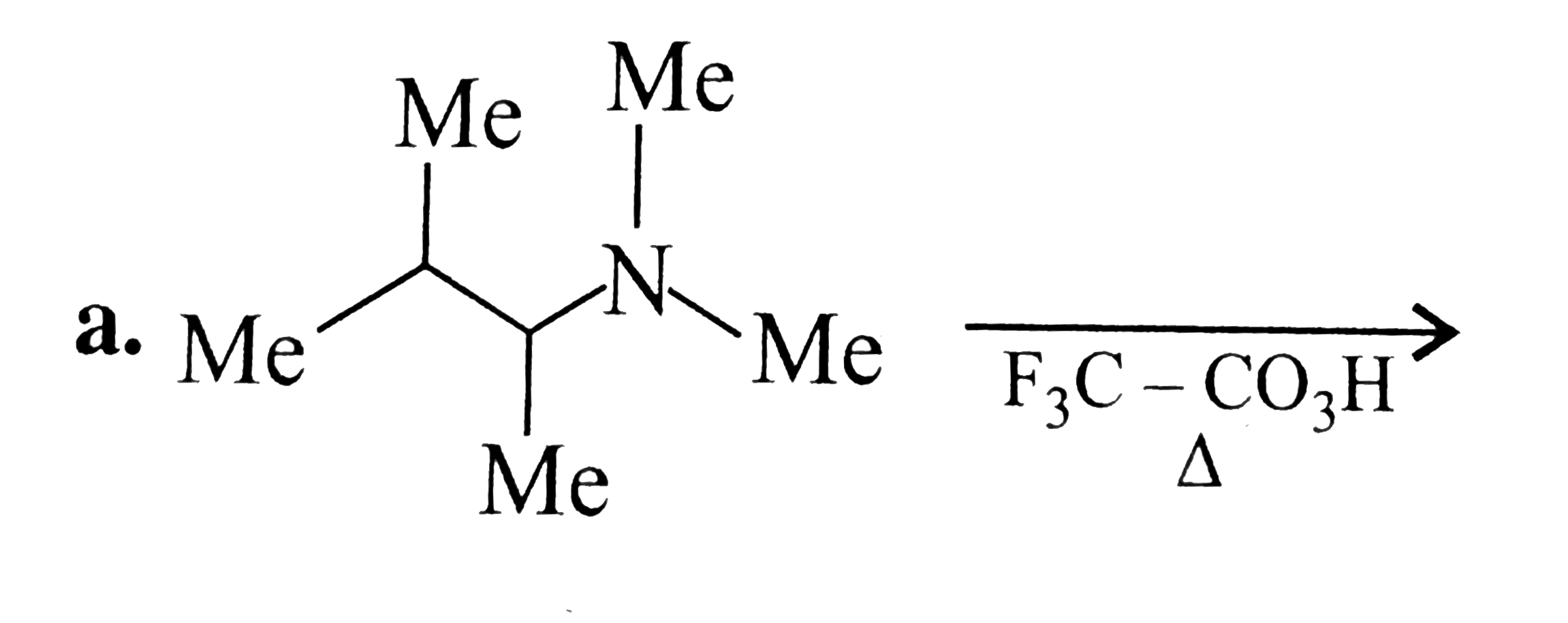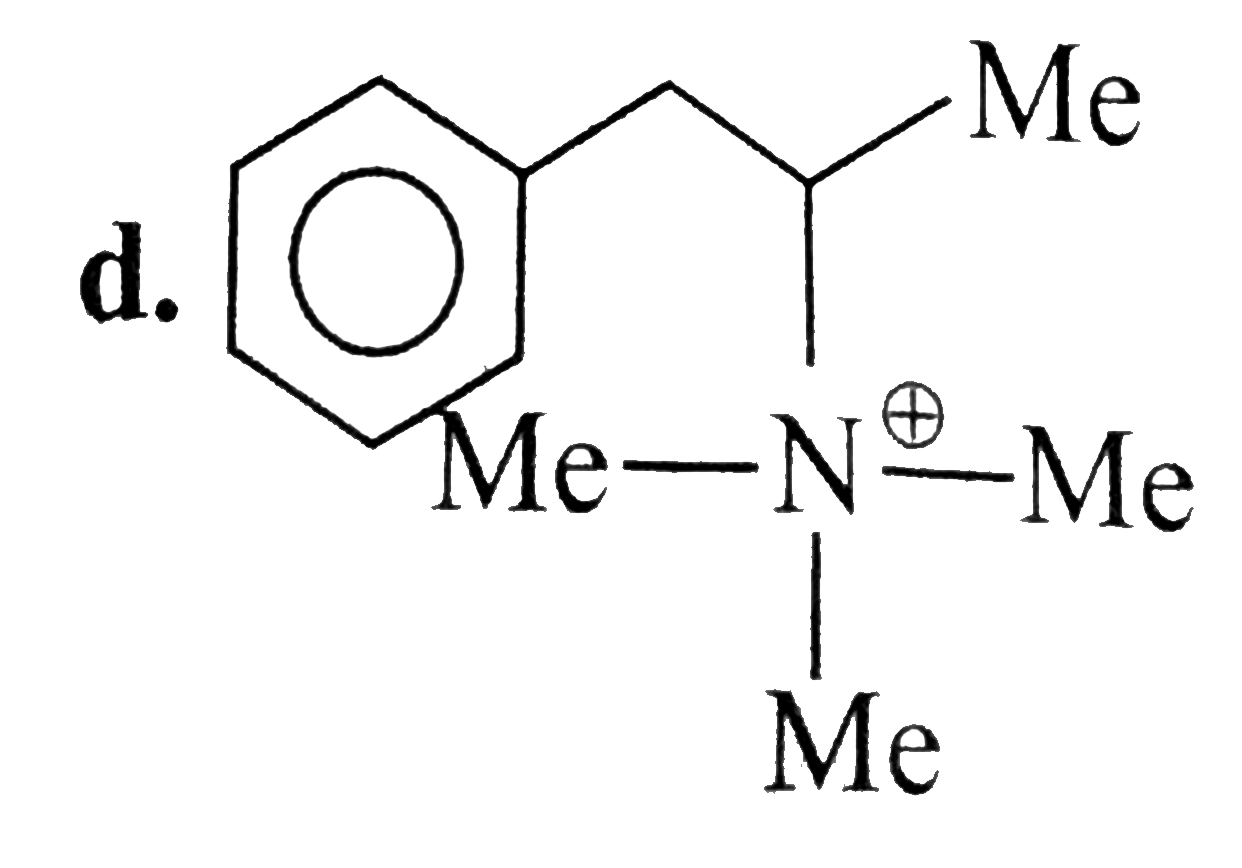Which of the following will give Hofamann alkene?




The correct Answer is:(a,b,c)
To determine which of the given reactions will yield a Hofmann alkene, we need to analyze each reaction step by step. A Hofmann alkene is characterized as a less substituted alkene that is formed during elimination reactions, particularly when a bulky base is used or when a poor leaving group is involved.
1. Understanding Hofmann Alkene:
- Hofmann alkene refers to the less substituted alkene that is formed during elimination reactions. This is often the result of using a bulky base or a poor leaving group.
2. Analyzing Reaction A (Cope Reaction):
- In the Cope reaction, the formation of an intermediate occurs where a nitrogen atom carries a positive charge and is surrounded by methyl groups.
- The elimination process leads to the formation of a less substituted alkene.
- Conclusion: Reaction A produces a Hofmann alkene.
3. Analyzing Reaction B:
- In this case, a bulky base is used for elimination.
- The bulky base favors the formation of the less substituted alkene by removing the leaving group and a hydrogen atom from the less hindered side.
- Conclusion: Reaction B also produces a Hofmann alkene.
4. Analyzing Reaction C:
- Here, fluorine is identified as a poor leaving group due to the strong carbon-fluorine bond.
- The elimination reaction will still favor the formation of the less substituted alkene due to the poor leaving ability of fluorine.
- Conclusion: Reaction C produces a Hofmann alkene as well.
5. Analyzing Reaction D:
- In this reaction, the elimination leads to the formation of a more substituted alkene.
- The presence of extended conjugation stabilizes the more substituted alkene, making it the preferred product.
- Conclusion: Reaction D does not produce a Hofmann alkene; it produces a more stable, more substituted alkene (Saytzeff product).
Final Answer:
- The reactions that will give Hofmann alkene are A, B, and C. Reaction D does not yield a Hofmann alkene.
- Hofmann alkene refers to the less substituted alkene that is formed during elimination reactions. This is often the result of using a bulky base or a poor leaving group.
- In the Cope reaction, the formation of an intermediate occurs where a nitrogen atom carries a positive charge and is surrounded by methyl groups.
- The elimination process leads to the formation of a less substituted alkene.
- Conclusion: Reaction A produces a Hofmann alkene.
- In this case, a bulky base is used for elimination.
- The bulky base favors the formation of the less substituted alkene by removing the leaving group and a hydrogen atom from the less hindered side.
- Conclusion: Reaction B also produces a Hofmann alkene.
- Here, fluorine is identified as a poor leaving group due to the strong carbon-fluorine bond.
- The elimination reaction will still favor the formation of the less substituted alkene due to the poor leaving ability of fluorine.
- Conclusion: Reaction C produces a Hofmann alkene as well.
- In this reaction, the elimination leads to the formation of a more substituted alkene.
- The presence of extended conjugation stabilizes the more substituted alkene, making it the preferred product.
- Conclusion: Reaction D does not produce a Hofmann alkene; it produces a more stable, more substituted alkene (Saytzeff product).
- The reactions that will give Hofmann alkene are A, B, and C. Reaction D does not yield a Hofmann alkene.
Topper's Solved these Questions
- AROMATIC COMPOUNDS AND ALKYL AND ARYL HALIDES BOOK - CENGAGE CHEMISTRY ENGLISHCHAPTER - AROMATIC COMPOUNDS AND ALKYL AND ARYL HALIDES EXERCISE - Exercises Multiple Correct Answers Type
15 Videos
- AROMATIC COMPOUNDS AND ALKYL AND ARYL HALIDES BOOK - CENGAGE CHEMISTRY ENGLISHCHAPTER - AROMATIC COMPOUNDS AND ALKYL AND ARYL HALIDES EXERCISE - Exercises Single Correct Answer Type
28 Videos
- AROMATIC COMPOUNDS AND ALKYL AND ARYL HALIDES BOOK - CENGAGE CHEMISTRY ENGLISHCHAPTER - AROMATIC COMPOUNDS AND ALKYL AND ARYL HALIDES EXERCISE - Exercises Linked Compreshension Type
11 Videos
- APPENDIX INORGANIC VOLUME 2BOOK - CENGAGE CHEMISTRY ENGLISHCHAPTER - APPENDIX INORGANIC VOLUME 2EXERCISE - Short Answer Type
179 Videos
- BIOMOLECULESBOOK - CENGAGE CHEMISTRY ENGLISHCHAPTER - BIOMOLECULESEXERCISE - Exercises Archives (Analytical And Descriptive)
8 Videos
Similar Questions
Knowledge Check
Which of the following alcohols will give same alkene on reaction with conc. H2SO4 ?
A B
B C
C D
D
Which of the following alkene will give enantiomeric product on reaction with HBr?
A B
B C
C D
D
Consider the following reation.

Which of the following base will give the best yield of the alkene II as the major product ?ACH3O−BC2H5O−C(CH3)3CO−D(C2H5)3CO−
Which of the following reactions will not give Hofmann alkene ?
View SolutionWhich of the following compound will give three alkenes after dehydrohalogenation.
View SolutionWhich of the following alkenes will give same product by any method out of hydration, hydroboration-oxidation and oxymercuration-demercuration?
View SolutionWhich of the following alkylhalides will give one alkene (more than 90% ) on dehydrohalogenation under the presence of sodium alkoxide and Ethanol ?
View SolutionWhich of the following reactions will give least substituted alkene?
View Solution
